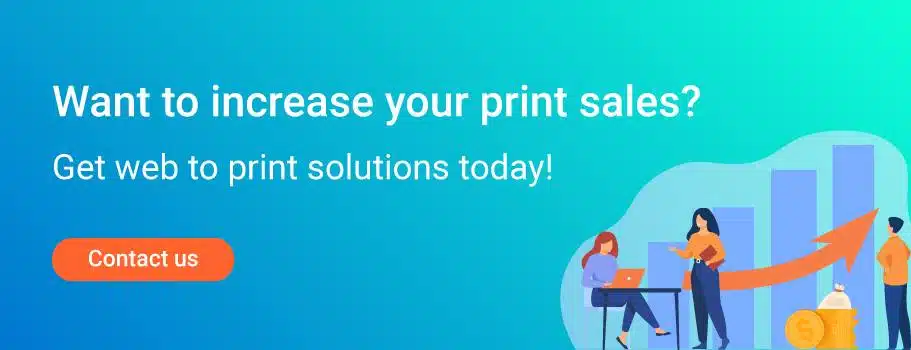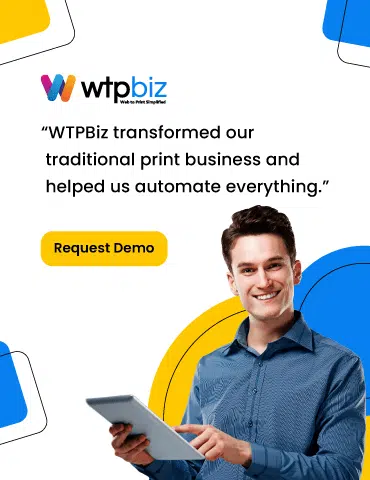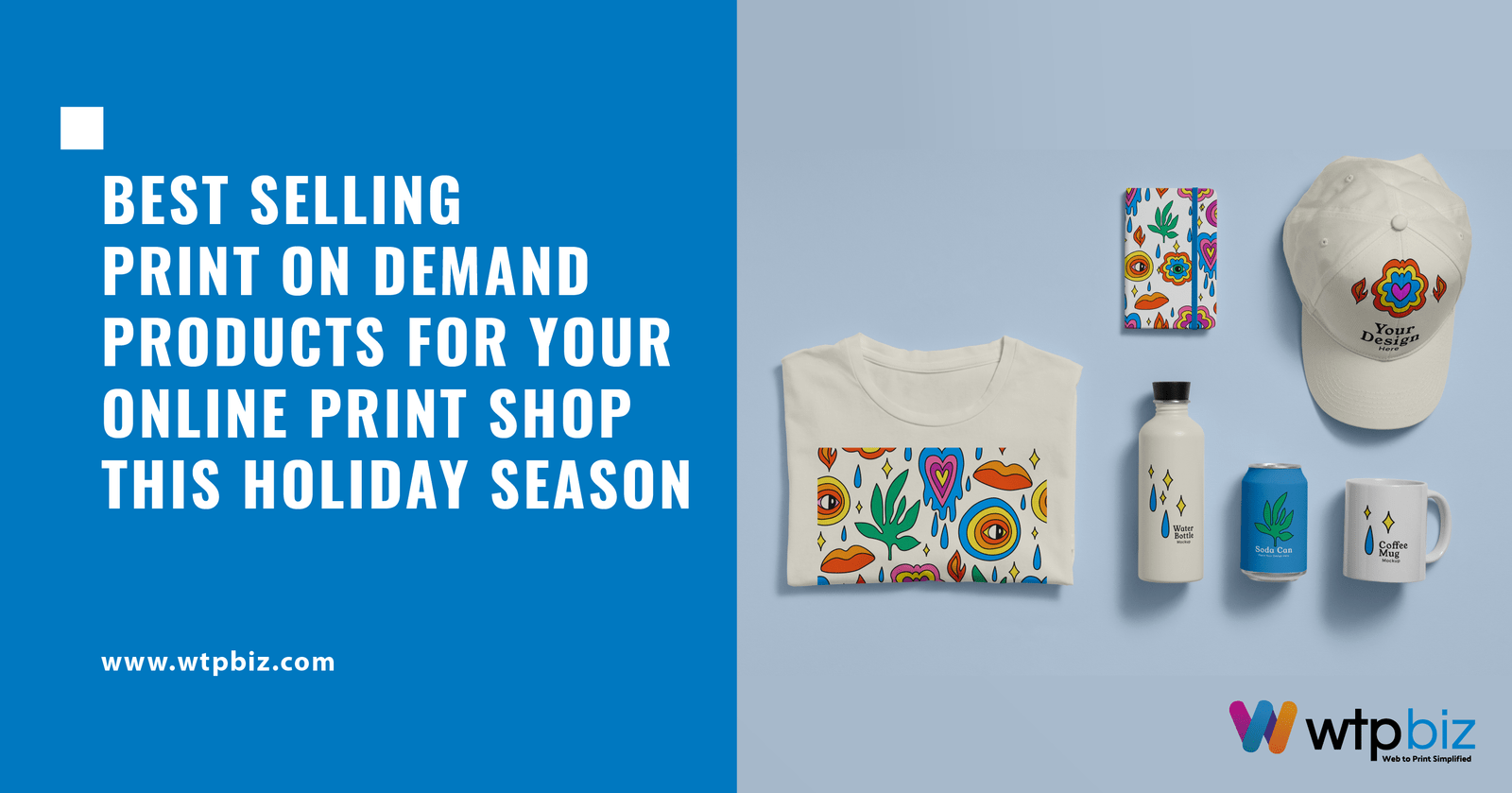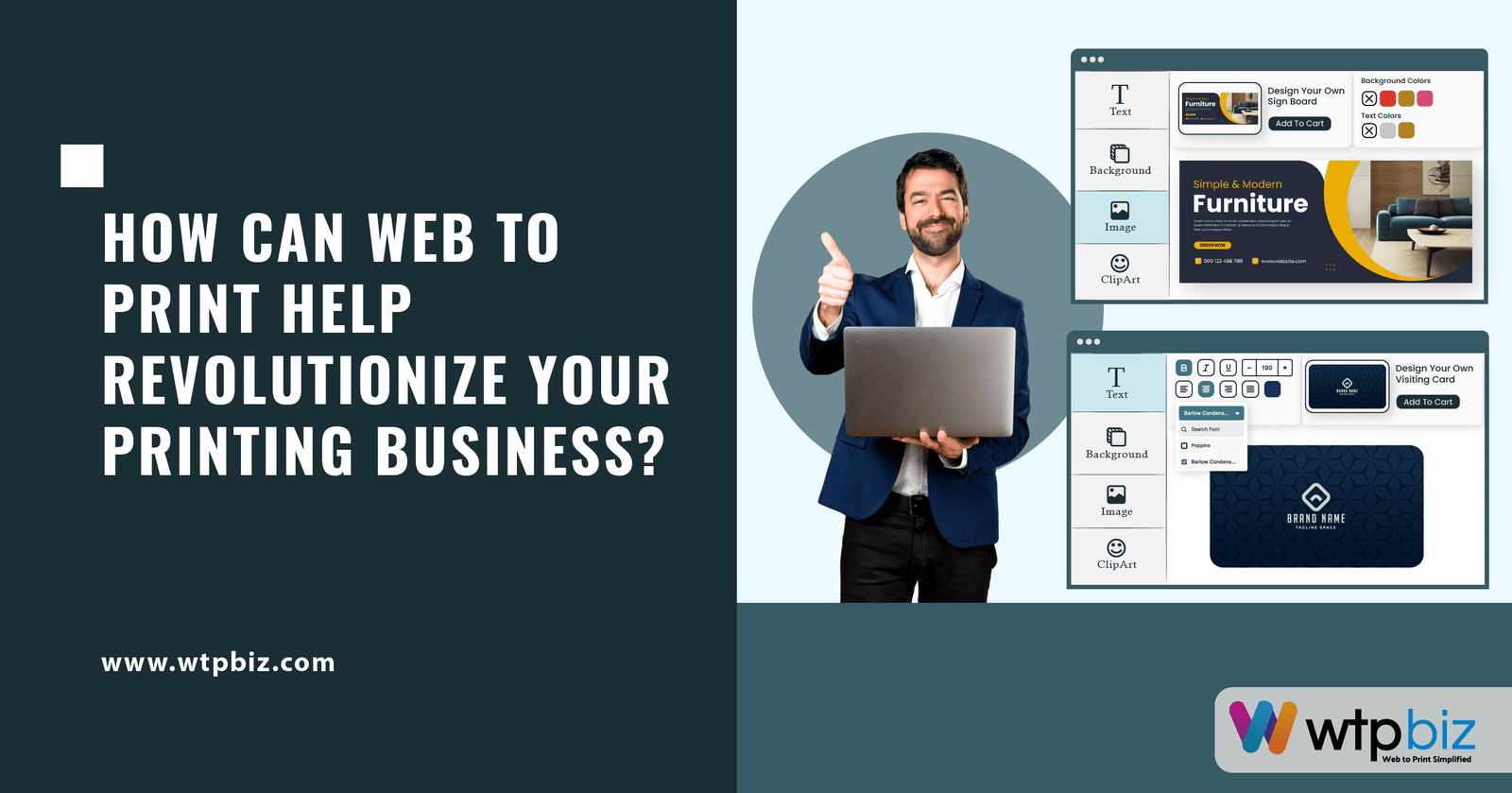Print Like a Pro: A Crash Course in the Latest Printing Techniques
Welcome, printing enthusiasts and web to print software aficionados!
Today we’re diving into the exciting world of printing methods used in the web to print industry. You may be thinking, “Why do I need to know about printing methods? Can’t I just click a button and have my design magically appear on a t-shirt?” Oh, how naive you are!
The truth is the printing method used can have a significant impact on the quality and durability of the final product. And let’s face it; nobody wants to wear a faded, peeling t-shirt that looks like it was printed in the Stone Age. So, if you’re running a web to print E-store or web to print store, you must know your stuff regarding printing methods.
In this article, we’ll give you a brief overview of the eight types of printing methods commonly used in the web to print industry. We’ll cover everything from classic offset printing to modern dye-sublimation printing.
But before diving in, we must thank our web to print software provider, WTPBiz. Without them, this article wouldn’t exist! So, if you’re in the printing industry and looking for top-notch web to print software, check them out. Now, let’s get down to business and explore the wonderful world of printing methods. Buckle up, and it’s going to be a wild ride!
 1. Offset Printing:
1. Offset Printing:
First up, we have the one and only Offset Printing. It’s the granddaddy of printing methods, and it’s been around longer than the internet (gasp!). For those who don’t know what offset printing is (and shame on you!), it’s a process where ink is transferred from a plate to a rubber sheet and then to the printing surface. It’s a game of telephone but with ink.
- Advantages and disadvantages of offset printing
So, what are the advantages of offset printing? Well, for starters, it’s great for large print runs. You know, those annoying tasks where you need a gazillion copies of something? Offset printing has got your back. It also produces high-quality prints with sharp, clean lines and vibrant colours. And let’s not forget about its ability to print on a wide range of materials, including paper, cardboard, and even metal.
But, like any printing method, offset printing has its downsides. For one, it’s not the cheapest option, especially for small print runs. It also requires some setup time, which can be a pain if you’re in a rush. And finally, it’s not great for printing variable data (i.e., personalised info on each print), which is a bummer if you’re looking to create a bunch of unique prints.
- Applications of offset printing in the web-to-print industry
Now, let’s talk about the applications of offset printing in the web to print industry. If you’re running a web to print E-store or store, offset printing can be a great way to produce large quantities of prints at a high quality. Think brochures, flyers, and posters. It’s also a great option for printing business cards, letterheads, and other stationary items. And, if you’re feeling fancy, you can even print on speciality materials like textured paper or metallic foil.
2. Digital Printing:
Digital printing is a method that uses digital files to print images directly onto a variety of materials. This printing method has revolutionised the printing industry, making it faster, more accurate, and more affordable. With digital printing, you can now easily print anything from business cards to banners.
- Advantages and disadvantages of digital printing
What advantages of digital printing? Where do we start? It’s like comparing a Ferrari to a horse-drawn carriage. Digital printing is faster, more accurate, and can print high-quality images. It’s like having your own personal printing genie that can easily grant your printing wishes. However, like all good things, it does have a few disadvantages. The quality of digital printing is dependent on the quality of the digital file used. If the digital file is low quality, the printed image will be too. Plus, digital printing can be expensive for large print runs.
- Applications of digital printing in the web-to-print industry
But enough about the nitty-gritty, let’s talk about the fun stuff – applications of digital printing in the web to print industry! With digital printing, you can now create customised products quickly and easily. Whether you’re printing personalised business cards, brochures, or banners, digital printing makes it easy to bring your vision to life. Plus, with the rise of web to print software providers like WTPBiz, creating a web-to-print store has never been easier. With their web to print E-store, you can easily upload and print your designs and have them shipped straight to your door.
3. Flexography
First up, we have Flexography. Sounds like a mouthful, doesn’t it? But don’t worry; it’s not as complicated as it sounds. Flexography is a printing process that uses a flexible relief plate to transfer ink onto a substrate. Think of it as a giant rubber stamp used to print on things like packaging materials, labels and envelopes.
- Advantages and disadvantages of flexography
What are the advantages of using Flexography? Well, it’s a versatile printing method used on various surfaces. It’s also a high-speed process that can print up to 300 meters per minute. That’s faster than a “web to print software provider”! And since Flexography uses a roll-to-roll process, it’s perfect for large print runs.
But as with everything in life, there are also some disadvantages to using Flexography. For example, it’s not the best option for printing high-quality images or fine text. The printing plates can also be quite expensive, which can be a downside for small businesses or web to print E-stores that are just starting.
- Applications of flexography in the web-to-print industry
Now, let’s discuss how Flexography is used in the web-to-print industry. Since Flexography is great for printing on packaging materials, it’s a popular choice for businesses that sell products online. For example, a web to print store that sells custom stickers or labels would benefit from using Flexography to print their designs. It’s also a popular choice for printing on paper bags, envelopes and other promotional materials.
4. Screen Printing
First up, we have the ever-reliable Screen Printing method. You may be thinking, “What the heck is screen printing?” Let me enlighten you. It’s a printing method where a mesh screen transfers ink onto a surface, with stencils blocking out the areas not meant to be printed.
- Advantages and disadvantages of screen printing
Now, what are the advantages and disadvantages of this method? Well, let’s start with the pros. Screen printing is a versatile method used on various surfaces, such as textiles, paper, and plastics. Plus, it produces high-quality prints that are durable and long-lasting. On the downside, it can be time-consuming, especially when creating multiple colour designs, and it can also be expensive when producing small quantities of prints.
- Applications of screen printing in the web-to-print industry
But fear not, dear reader, because screen printing has found its place in the web to print industry, with applications ranging from t-shirts and bags to business cards and banners. With the help of web to print software, screen printing has become more accessible and affordable for businesses of all sizes.
And speaking of web-to-print software, have you checked out WTPBiz? They’re a top-notch web-to-print software provider that can help you set up your web-to-print store. Imagine having your online printing shop accessible to customers from all over the world. Sounds pretty awesome.
5. Gravure Printing
Now, what is gravure printing, you ask? Well, it’s a printing technique that involves engraving an image onto a cylinder, which is then coated in ink and pressed onto paper. Think of it like a fancy, high-tech version of those old-school potato stamps you used to make in art class. But instead of a potato, you’ve got a shiny metal cylinder. And instead of sloppy finger painting, you’ve got precise, high-quality printing. Ah, the wonders of technology.
- Advantages and disadvantages of gravure printing
So, what are the advantages and disadvantages of gravure printing? Let’s start with the good stuff. Gravure printing produces incredibly high-quality images with consistent and even ink coverage. It can easily handle large print runs, making it a great choice for big jobs. On the downside, it can be pretty expensive, especially for smaller runs. And since the image is engraved onto the cylinder, it’s not as easy to make changes or adjustments as it is with other printing methods.
- Applications of gravure printing in the web-to-print industry
But enough about that technical stuff, let’s talk about the fun part – gravure printing applications in the web to print industry! You see, web to print stores and e-stores must handle various printing needs, from business cards to banners and everything in between. And gravure printing is versatile enough to handle it all. Need high-quality images for a fancy brochure? Gravure’s got you covered. Need a whole bunch of labels or packaging printed up? Gravure can handle the volume. It’s like the Swiss Army Knife of printing methods.
And speaking of Swiss Army Knives, that’s like what WTPBiz is for the web to print industry. They’re a web to print software provider with everything you need to run a successful web-to-print store. Need a storefront? They’ve got it. Need product design tools? They’ve got those too. Need a way to manage your orders and keep everything organized? You guessed it, they’ve got you covered. It’s like having a whole team of experts on your side but without the pesky human interaction.
6. Letterpress Printing
First up, we have letterpress printing. This printing method has been around since the 15th century, so it’s a senior citizen of the printing world. But don’t let its age fool you because it’s still a popular choice for many web-to-print stores.
For those new to the game, letterpress printing involves pressing ink onto paper using a raised plate. The plate is inked up and pressed onto the paper, creating a beautiful impression that gives the print a unique and tactile feel.
- Advantages and disadvantages of letterpress printing
But before you run off to update your web to print store with letterpress printing, let’s dive into some advantages and disadvantages. On the plus side, letterpress printing creates a stunning tactile impression on the paper that’s hard to replicate with digital printing methods. It’s also great for printing on thicker paper stocks and produces vibrant colours that really pop. On the downside, it’s a slower printing process and more expensive than digital printing, so it’s often used for smaller print runs or special occasions.
- Applications of letterpress printing in the web-to-print industry
You might wonder, “What kind of special occasions require letterpress printing?” Well, my dear reader, let me tell you. Letterpress printing is perfect for wedding invitations, business cards, and other print materials requiring elegance and sophistication. It’s also a great way to set your web-to-print store apart from the competition and offer something unique to your customers.
7. 3D Printing
Before you start picturing a printer with arms and legs, 3D printing, also known as additive manufacturing, creates three-dimensional objects from a digital file. The printer uses a layer-by-layer approach to create the object by adding material until the final product is complete. It’s like building a Lego model, but instead of using plastic bricks, you use various materials like plastic, metal, or food!
- Advantages and disadvantages of 3D printing
The advantages of 3D printing are endless, really. It allows faster and more efficient production, a huge advantage in the web-to-print industry. It also allows for greater design flexibility, which means you can create intricate and complex designs that would be impossible with traditional printing methods. Plus, it’s environmentally friendly since it reduces waste by using only the material needed for the project.
But let’s not forget about the downsides of 3D printing. First off, it can be quite expensive, especially for larger projects. And the printing speed can be slow, depending on the complexity of the design. Plus, the quality of the final product can vary depending on the material used and the printer’s capabilities.
- Applications of 3D printing in the web-to-print industry
Now, onto the fun stuff – applications of 3D printing in the web-to-print industry. The possibilities are endless! You can create custom phone cases, jewellery, and even toys. But why stop there? You can also create prototypes for product development or even architectural models. And for those who want to take it to the next level, you can even print food!
8. Dye Sublimation Printing
First things first, what the heck is dye sublimation printing? Well, let me tell you, it’s not as simple as slapping some ink on paper and calling it a day. Dye sublimation printing uses heat to transfer dye onto materials like polyester and polymer-coated substrates. The dye becomes a gas and then permeates the material’s fibres, creating a vibrant, long-lasting print.
- Advantages and disadvantages of dye sublimation printing
Now, let’s talk about the pros and cons of this fancy pants printing method. One of the biggest advantages is that the prints are incredibly durable and won’t fade. Plus, the colours are super vibrant and can be printed onto non-flat surfaces like curved mugs or phone cases. On the downside, the cost of dye sublimation printers and ink can be steep, so it’s not the best option for small-scale printing.
- Applications of dye sublimation printing in the web-to-print industry
But who cares about the downsides when there are so many fun applications of dye sublimation printing in the web to print industry? You can create custom t-shirts, hats, and bags with intricate designs and photographs. You can even print your personalized phone cases, mousepads, and coasters. The possibilities are endless, and the results are always stunning.
If you’re a printing business looking to up your game, then you need to check out WTPBiz. They offer web to print software to help you create your web to print e-store or web-to-print store. With their help, you can offer your customers dye sublimation printing and other cutting-edge printing methods, making you the go-to destination for all their printing needs.
Conclusion:
Well, folks, it’s time to wrap up our discussion on the 8 Types of Printing Methods Used by the Web-to-print Industry. And let me tell you; it’s been a wild ride. Who knew there were so many ways to get ink on paper? But thanks to our trusty web to print software providers like WTPBiz, we can now browse through an endless array of options on our web to print e-stores and web to print stores. Gone are the days of settling for plain old black and white prints. Now we can choose from everything from dye-sublimation to screen printing.
So if you’re in the printing industry and feeling overwhelmed by all these options, fear not! With the help of web-to-print software and web-to-print stores, you’ll be cranking out eye-catching prints in no time. And who knows, maybe one day you’ll even invent your own printing method to add to the list of eight. Until then, happy printing! And remember, support your local web to print store.
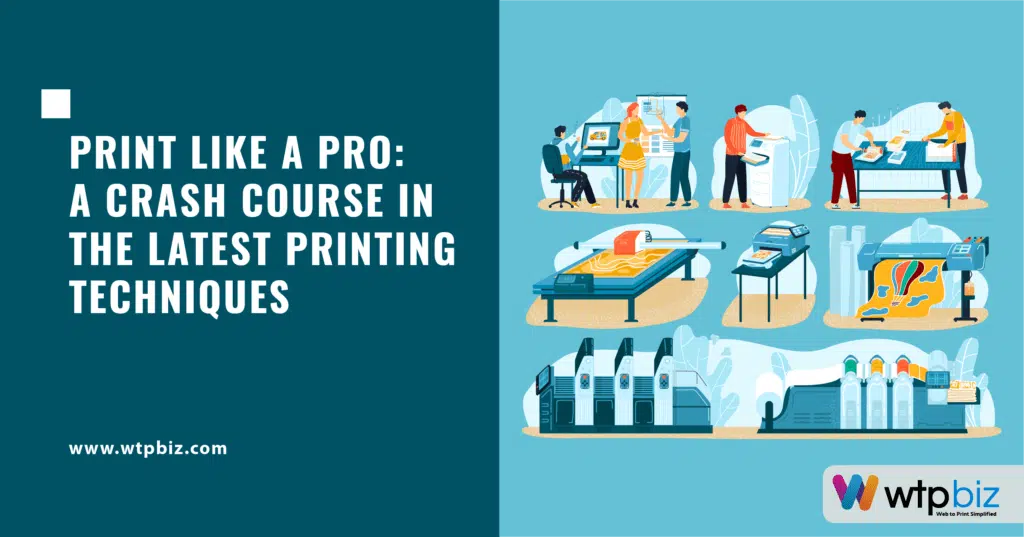
 1. Offset Printing:
1. Offset Printing: